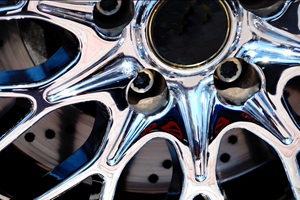Powder Coatings vs Energy-Cure Coatings
Examining the basic differences between powder coatings and energy-cure coatings can help answer the question of whether or not one of these technologies might be appropriate for a specific application.
Q: I’m currently using a solvent-borne coating in my process, but I’ve been hearing a lot about 100% solids coatings and wonder if they could be applicable in my coating operation?
A: To answer your question, let’s look at the two most common types of 100% solids coatings: powder coatings and energy-cure coatings.
Powder coating is often the first thing that comes to mind when someone mentions 100% solids coatings. It makes sense because, as the name implies, the coating is a powder with no solvents in it. This technology is well established, and the coatings are durable and emit virtually no volatile organic compounds (VOCs), which are attractive benefits over existing solvent-borne coating technology.
On the other hand, many people have never even heard of energy-cure coatings. These are often called ultraviolet (UV), UV-LED, or electron beam (EB) coatings. They can be deceiving because, unlike powder coatings, they start as a liquid, yet they’re formulated without solvents to evaporate, and 100% of the liquid is converted into the finished film so they are also defined as 100% solids coatings. They also emit virtually no VOCs.
Let’s examine the basic differences between the two technologies.
Powder Coating
The powder coating process was invented by Daniel Gustin and Albert Wainio in the early 1940s for which they received U.S. Patent 2,538,562 in 1945.
Powder coatings are applied by spraying and require electrostatics to draw the powder onto the part and hold it there until it is melted. Not a problem with metals, but this can present issues with non-conductive substrates and require special considerations — just like those required for liquid painting. Moreover, powder coating films are often much higher — often 2.5–3.0 mils (60–80 micrometers) — than their solvent-borne counterparts, which are often in the 0.8–1.6 mil (20–40 micrometer) range.
Powder coating is a thermal cure technology, which means that the coating is cured by baking — or bringing it to an elevated temperature — which melts the powder into a liquid, enabling it to flow and form a continuous film, then initiates the cross-linking process to cure the film. As with your existing solvent-borne coatings, it is necessary to heat both the part and the coating, so the baking process is performed in an oven. This is suitable for durable, heat resistant substrates like metals, glass and ceramics, stone, and so on. Though there are low temperature powder coatings available, the heating required is often still too high for more delicate, heat sensitive substrates like wood, plastic, and more. And though regenerative thermal oxidizers (RTOs) are not required to burn off VOCs, ovens still consume a great deal of energy.
Energy-Cure Coatings
Energy-cure coatings are often thought of as something new. In fact, the foundation for UV, EB and UV-LED technology was developed in the late 1920s by Edwin Newton of the B.F. Goodrich Co. to "vulcanize" natural rubber — a process for which he received U.S. Patent 1,906,402, filed in 1929 and issued in 1933. It is still used in tire manufacturing today. UV curing began to evolve in the 1960s with major commercialization during the 1970s driven by the energy crises brought on by the OPEC oil embargo of 1973. It’s older than the powder coating process by more than a decade.
Because these are liquid coatings, they can be applied by spraying, but they can also be applied in roll coating and flow or curtain coating operations. They have also been shown to provide significantly better performance at much thinner films than both solvent-borne and powder coatings — often 0.5–1.0 mils (10–25 micrometers).
The curing/cross-linking process is initiated by exposing the coating to either high-energy light waves, often in the UV band, or high-energy electrons. Because this energy is focused directly on the coating — and the parts don’t have to be heated — it is far more efficient, requiring significantly less energy (as much as 95% less) to perform the curing function.
Advancements in chemistry over the last 50 years have made an extensive number of options available to formulate coatings to meet a variety of cured film properties. This makes 100% solids technology available to virtually any application.
If you are coating metal parts and already have an oven, converting to powder coating may be your easiest option. If your application is one where powder coatings simply won’t work, or you need greater energy savings than only eliminating your RTO can provide, then an energy-cure coating solution can provide the means to meet your operational goals.
About the Author
Michael Bonner
Michael Bonner is the vice president of engineering and technology for Saint Clair Systems. Visit viscosity.com.
Related Content
Deoxidizing Aluminum as a Pretreatment
This important first step can help prepare the metal for subsequent surface finishing.
Read MoreA Chromium Plating Overview
An overview of decorative and hard chromium electroplating processes.
Read MoreRead Next
Finishing Temperature-Sensitive Material with UV Powder Coating
Quality issues with pre-finished components led Global Building Products on a search to discover a new solution for its temperature-sensitive materials.
Read MorePowder Coating 4.0: Smarter, Faster, More Efficient and Connected
New tools reduce cost and waste, lower manufacturing footprint of powder coating operations.
Read MoreThe 2024 Ford Mustang: All the Colors Available
Although Chevrolet has announced the end of the Camaro and Dodge is offering “Last Call” editions of the Charger and Challenger, the Ford Mustang is launching to its seventh generation.
Read More


























